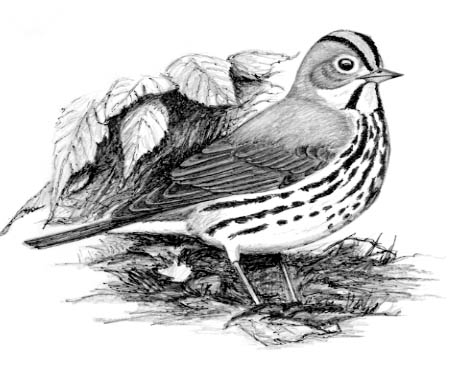
Dear Bird Folks,
Please find the attached video clip. Note: In the clip you are only going to see a bunch of trees, so don’t look for anything special. It’s the soundtrack I want you to hear. Somewhere in those trees a bird is loudly singing. To my ears it sounds like the bird is saying “meet-cha, meet-cha, meet-cha,” but I can never find it. Could you please tell me what bird is doing the singing?
– Paul, Plymouth, MA
It’s okay, Paul,
Don’t feel bad about your movie. I don’t mind watching a video of trees. It’s still better than most things on TV. Besides, your clip did its job. I can clearly hear your mystery bird. It’s an Ovenbird. Ovenbirds are noted for their distinctive songs. However, this is the first time I’ve heard anyone assert that the bird is saying, “meet-cha, meet-cha, meet-cha,” (It sounds like the slogan of a low-end dating service.) Birders typically claim the bird says “teacher, teacher, teacher.” Except in the Bible Belt where they hear “preacher, preacher, preacher.” And in Georgia they hear, “peaches, peaches, peaches.” Or, something like that.
The Ovenbird is a small olive-brown bird, with speckles on the chest and a cool mohawk-style streak of orange across the top of its head. This bird spends most of its life creeping along the ground, acting and looking very much like a thrush. Yet, believe it or not, Ovenbirds are actually warblers. We think of warblers as colorful, energetic birds that like to flit through the tops of trees. But Ovenbirds are calm, not-so-colorful dwellers of the forest floor. And they don’t do much flitting.
The first thing people want to know about this atypical warbler is how it got its odd name. Why Ovenbird? Some references claim that these birds were given this title because their nests are shaped like “Dutch ovens.” Hmm. I’ve never seen a Dutch oven before, so I looked it up. It turns out a Dutch oven is not really an oven at all. It’s a cooking pot with a handle and a cast iron cover. This bird’s nest looks nothing like that. The Ovenbird builds its nest directly on the ground. To hide it from predators, the bird constructs a dome over it, using sticks and leaves. Finally, for a finishing touch, it lines its nest with deer fur. While these nests appear to be warm and cozy, and well concealed, they don’t look much like cooking pots. To me, they look more like brick pizza ovens. I don’t know where the Dutch thing came from. Do the Dutch even make pizza?
Because Ovenbirds are fond of deep woods, they are one of the many birds that have benefited from the re-growth of our local forest. The latest breeding bird survey suggests that their population is increasing. Yay! Just about any woodland walk (in the spring) gives you a good chance of hearing their aforementioned loud song. Last week I did some birding in Hingham’s Wompatuck State Park. The park is noted for migrating spring warblers, but on this day I was with my birding buddy, Fahy. Chronologically, Fahy is a long way from being a teenager, but she still clings to a few teenage tendencies, including sleeping late. As a result, we didn’t arrive at the park until the crack of 10:30 am. By then all of the warblers had stopped singing. Well, all but one. Ovenbirds will sing anytime and on this day, they were singing everywhere. The forest was filled with the sounds of “teacher, teacher, teacher.” (It was like being in an elementary school.) As was the case with your “tree” video, Paul, I could hear one bird singing just a few feet away, but I couldn’t see it. Fahy opted not to challenge the dense vegetation but I wanted to have a look at this Ovenbird, so I went for it.
The coloring of an Ovenbird makes it nearly impossible to see it as it pokes about on the forest floor. Fortunately for birders, these birds never shut up, especially when there’s competition nearby. If an Ovenbird hears a rival singing, it feels compelled to repond. About 300 feet away from me I could scarcely hear the song of another Ovenbird, but “my” bird could clearly hear it and wasn’t happy. Each time the distant bird sang, the bird in front of me answered back…yet, I still couldn’t see it. This went on for about ten frustrating minutes. I could hear the bird (and could also hear Fahy laughing at me) but saw nothing except trees. Then my efforts paid off. Somehow, I managed to focus on the right spot and there, walking along a moss-covered log, a diminutive Ovenbird appeared, orange mohawk and all. As I stared, the bird continued to sing, totally oblivious to the dopey birder who had been trying track it down. Usually birds scatter at the sight of encroaching humans, but Ovenbirds don’t seem to mind us and often allow for a close approach. (These are the kind of birds l like.)
Just about any local wooded area should have singing Ovenbirds this time of year, Paul, so don’t give up on your quest to see one. You already know what they sound like, so just keep looking. Eventually, one will come out of hiding and when it does, it will be glad to finally “meet-cha, meet-cha, meet-cha.”
On a different topic:
June is when birds feed their babies insects and spend less time at our feeders. It happens every year and it will pass, so please don’t call me blaming your birdseed. Blame the bugs, not your seed. Honest.